2004 PONTIAC GRAND AM child seat
[x] Cancel search: child seatPage 53 of 364
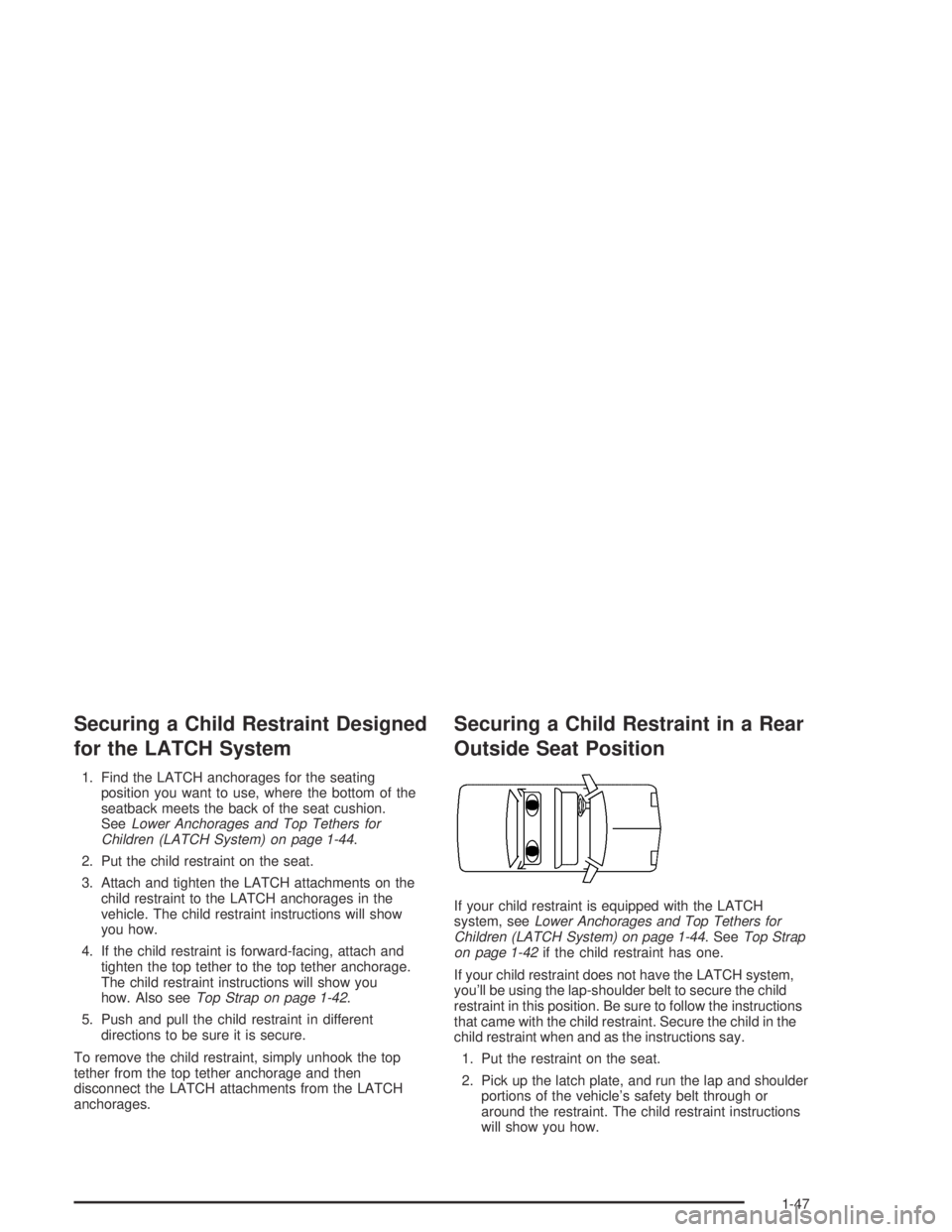
Securing a Child Restraint Designed
for the LATCH System
1. Find the LATCH anchorages for the seating
position you want to use, where the bottom of the
seatback meets the back of the seat cushion.
SeeLower Anchorages and Top Tethers for
Children (LATCH System) on page 1-44.
2. Put the child restraint on the seat.
3. Attach and tighten the LATCH attachments on the
child restraint to the LATCH anchorages in the
vehicle. The child restraint instructions will show
you how.
4. If the child restraint is forward-facing, attach and
tighten the top tether to the top tether anchorage.
The child restraint instructions will show you
how. Also seeTop Strap on page 1-42.
5. Push and pull the child restraint in different
directions to be sure it is secure.
To remove the child restraint, simply unhook the top
tether from the top tether anchorage and then
disconnect the LATCH attachments from the LATCH
anchorages.
Securing a Child Restraint in a Rear
Outside Seat Position
If your child restraint is equipped with the LATCH
system, seeLower Anchorages and Top Tethers for
Children (LATCH System) on page 1-44. SeeTop Strap
on page 1-42if the child restraint has one.
If your child restraint does not have the LATCH system,
you’ll be using the lap-shoulder belt to secure the child
restraint in this position. Be sure to follow the instructions
that came with the child restraint. Secure the child in the
child restraint when and as the instructions say.
1. Put the restraint on the seat.
2. Pick up the latch plate, and run the lap and shoulder
portions of the vehicle’s safety belt through or
around the restraint. The child restraint instructions
will show you how.
1-47
Page 55 of 364
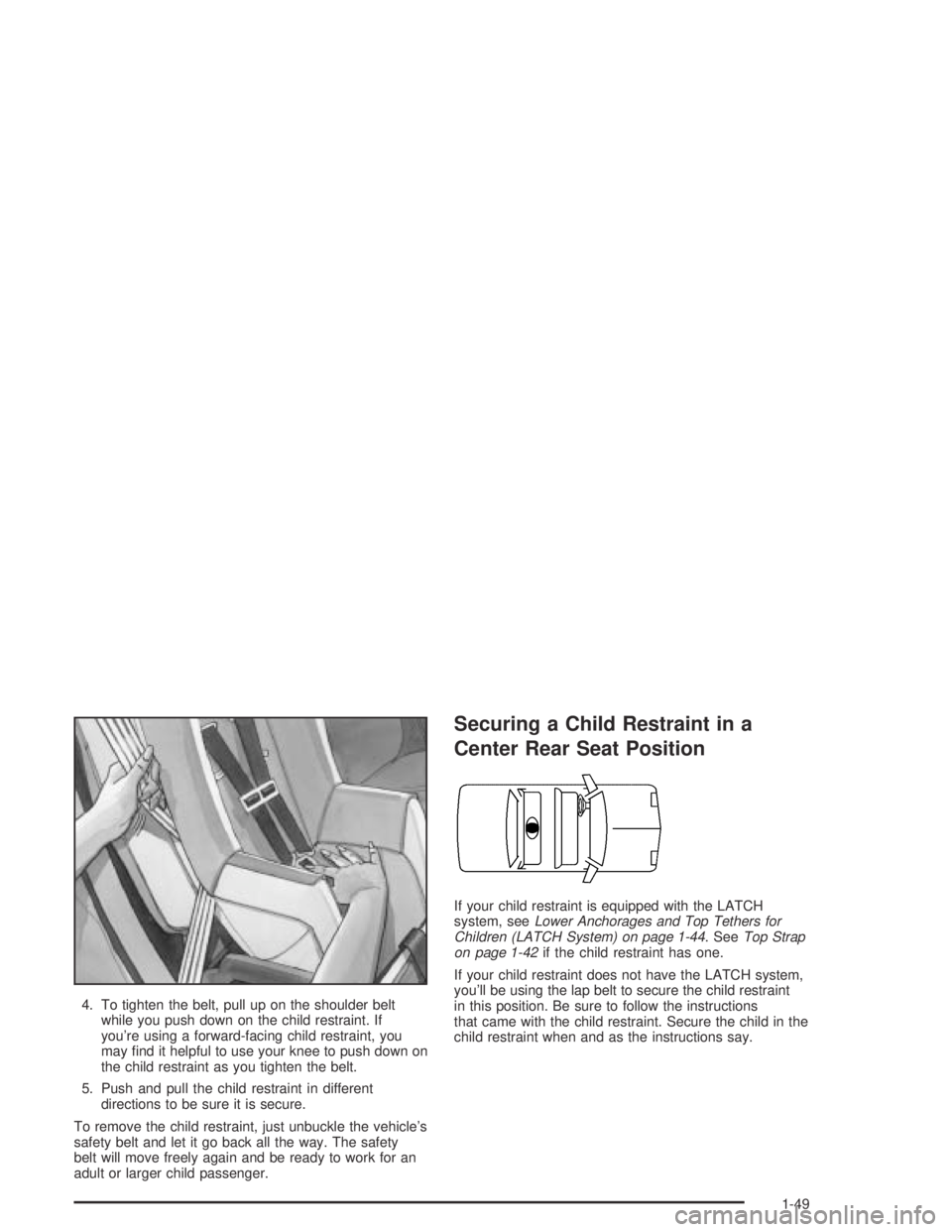
4. To tighten the belt, pull up on the shoulder belt
while you push down on the child restraint. If
you’re using a forward-facing child restraint, you
may find it helpful to use your knee to push down on
the child restraint as you tighten the belt.
5. Push and pull the child restraint in different
directions to be sure it is secure.
To remove the child restraint, just unbuckle the vehicle’s
safety belt and let it go back all the way. The safety
belt will move freely again and be ready to work for an
adult or larger child passenger.
Securing a Child Restraint in a
Center Rear Seat Position
If your child restraint is equipped with the LATCH
system, seeLower Anchorages and Top Tethers for
Children (LATCH System) on page 1-44. SeeTop Strap
on page 1-42if the child restraint has one.
If your child restraint does not have the LATCH system,
you’ll be using the lap belt to secure the child restraint
in this position. Be sure to follow the instructions
that came with the child restraint. Secure the child in the
child restraint when and as the instructions say.
1-49
Page 56 of 364
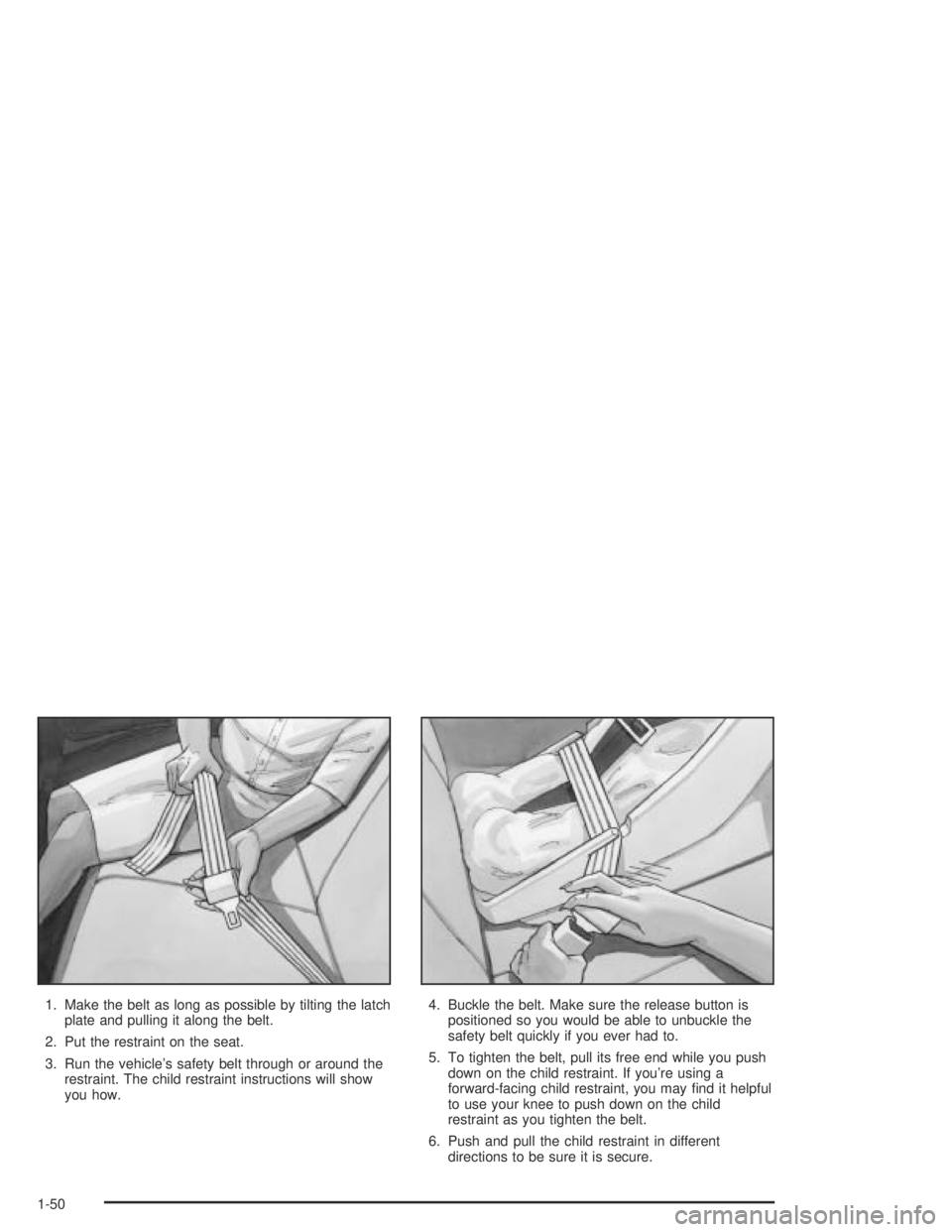
1. Make the belt as long as possible by tilting the latch
plate and pulling it along the belt.
2. Put the restraint on the seat.
3. Run the vehicle’s safety belt through or around the
restraint. The child restraint instructions will show
you how.4. Buckle the belt. Make sure the release button is
positioned so you would be able to unbuckle the
safety belt quickly if you ever had to.
5. To tighten the belt, pull its free end while you push
down on the child restraint. If you’re using a
forward-facing child restraint, you may find it helpful
to use your knee to push down on the child
restraint as you tighten the belt.
6. Push and pull the child restraint in different
directions to be sure it is secure.
1-50
Page 57 of 364
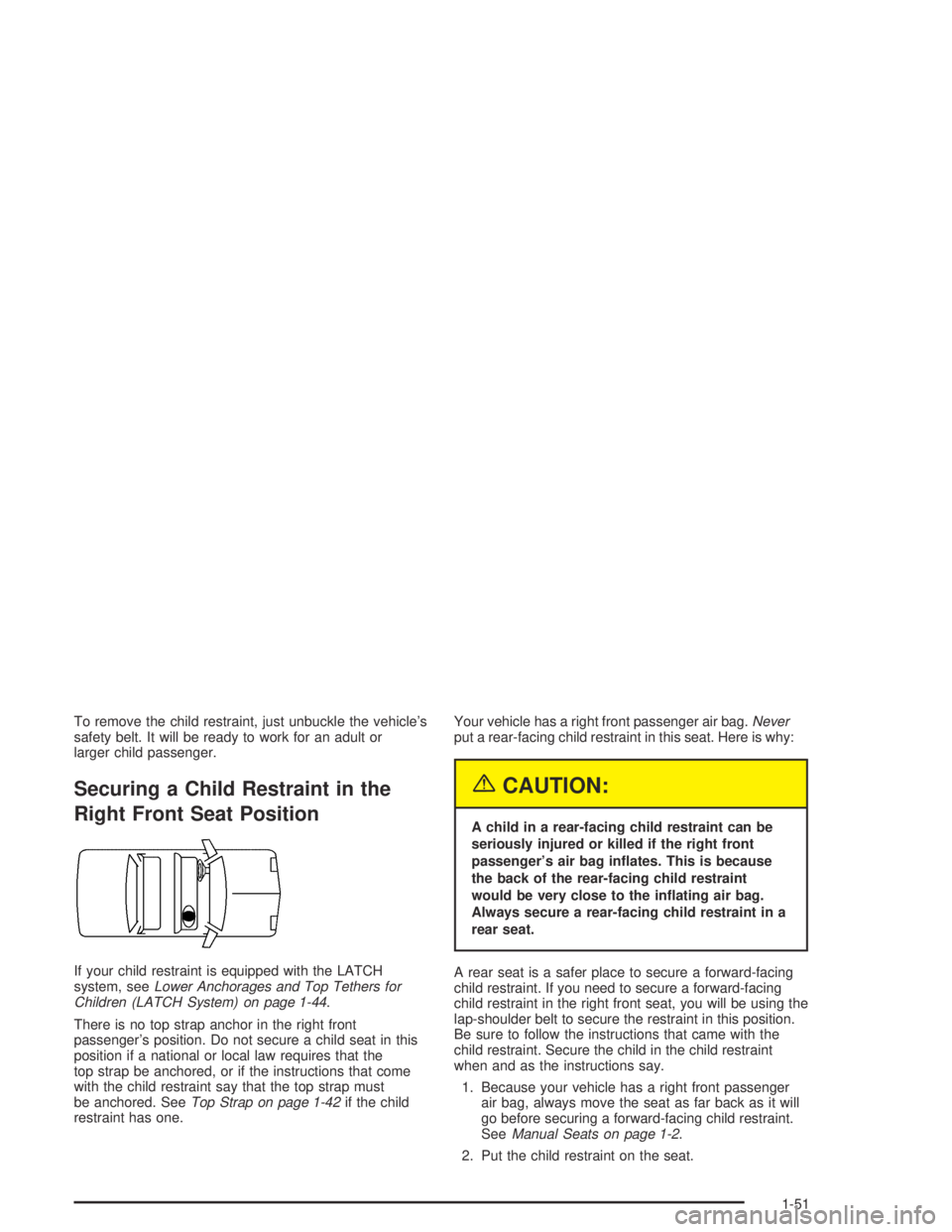
To remove the child restraint, just unbuckle the vehicle’s
safety belt. It will be ready to work for an adult or
larger child passenger.
Securing a Child Restraint in the
Right Front Seat Position
If your child restraint is equipped with the LATCH
system, seeLower Anchorages and Top Tethers for
Children (LATCH System) on page 1-44.
There is no top strap anchor in the right front
passenger’s position. Do not secure a child seat in this
position if a national or local law requires that the
top strap be anchored, or if the instructions that come
with the child restraint say that the top strap must
be anchored. SeeTop Strap on page 1-42if the child
restraint has one.Your vehicle has a right front passenger air bag.Never
put a rear-facing child restraint in this seat. Here is why:
{CAUTION:
A child in a rear-facing child restraint can be
seriously injured or killed if the right front
passenger’s air bag in�ates. This is because
the back of the rear-facing child restraint
would be very close to the in�ating air bag.
Always secure a rear-facing child restraint in a
rear seat.
A rear seat is a safer place to secure a forward-facing
child restraint. If you need to secure a forward-facing
child restraint in the right front seat, you will be using the
lap-shoulder belt to secure the restraint in this position.
Be sure to follow the instructions that came with the
child restraint. Secure the child in the child restraint
when and as the instructions say.
1. Because your vehicle has a right front passenger
air bag, always move the seat as far back as it will
go before securing a forward-facing child restraint.
SeeManual Seats on page 1-2.
2. Put the child restraint on the seat.
1-51
Page 82 of 364

Emergency Trunk Release Handle
Notice:Using the emergency trunk release handle
as a tie-down or anchor point when securing
items in the trunk may damage it. Use the
emergency trunk release handle only to help you
open the trunk lid.
There is a glow-in-the-dark emergency trunk release
handle located inside the trunk on the trunk latch. This
handle will glow following exposure to light. Pull the
release handle up to open the trunk from the inside.
Trap-Resistant Trunk Kit
To help prevent a child from becoming trapped in your
trunk, you can order a trap-resistant trunk kit from
your dealer. This kit includes:
•a modified trunk latch,
•a lighted release handle, and
•seatback tethers (for vehicles with folding rear
seatbacks).
See your dealer for additional information.
2-14
Page 218 of 364
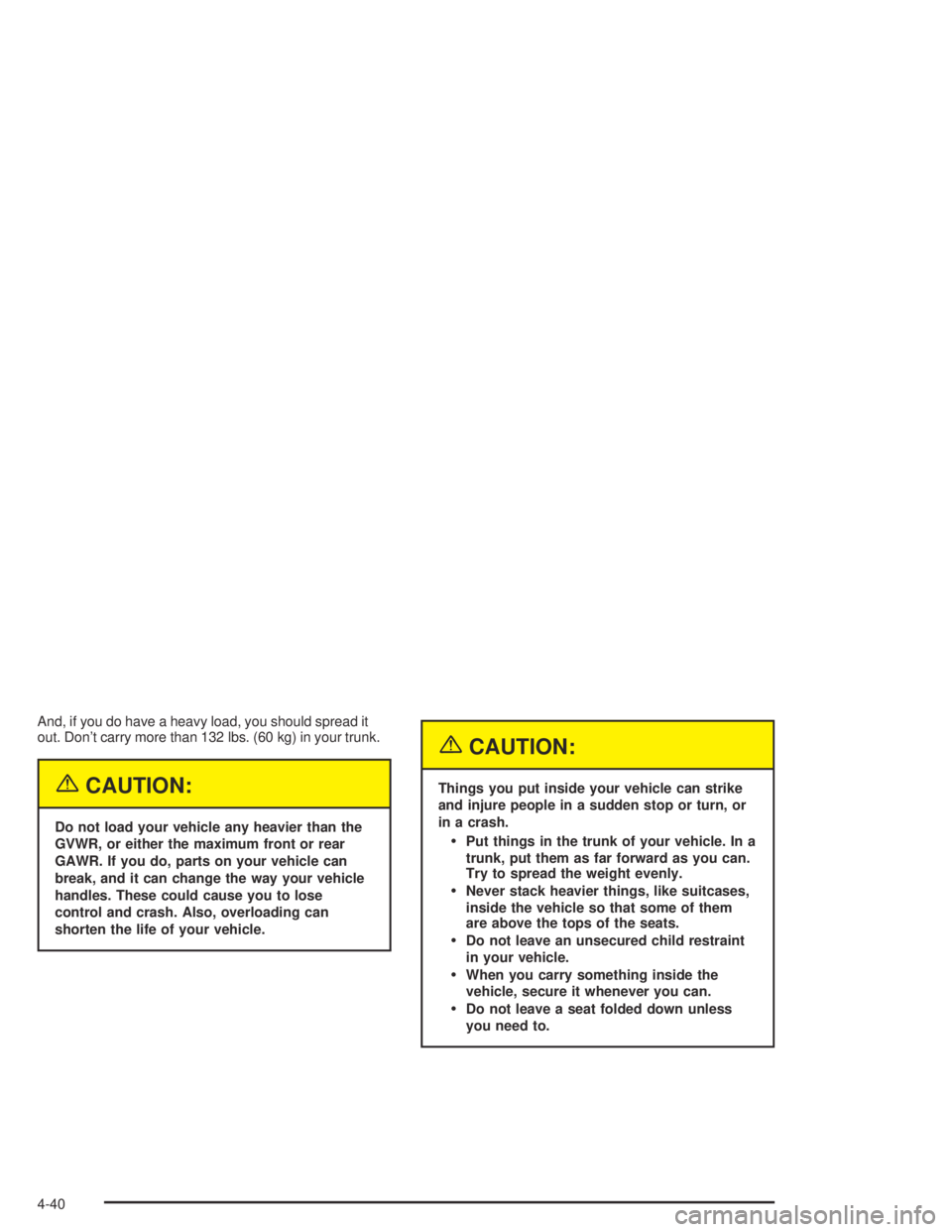
And, if you do have a heavy load, you should spread it
out. Don’t carry more than 132 lbs. (60 kg) in your trunk.
{CAUTION:
Do not load your vehicle any heavier than the
GVWR, or either the maximum front or rear
GAWR. If you do, parts on your vehicle can
break, and it can change the way your vehicle
handles. These could cause you to lose
control and crash. Also, overloading can
shorten the life of your vehicle.
{CAUTION:
Things you put inside your vehicle can strike
and injure people in a sudden stop or turn, or
in a crash.
Put things in the trunk of your vehicle. In a
trunk, put them as far forward as you can.
Try to spread the weight evenly.
Never stack heavier things, like suitcases,
inside the vehicle so that some of them
are above the tops of the seats.
Do not leave an unsecured child restraint
in your vehicle.
When you carry something inside the
vehicle, secure it whenever you can.
Do not leave a seat folded down unless
you need to.
4-40
Page 351 of 364
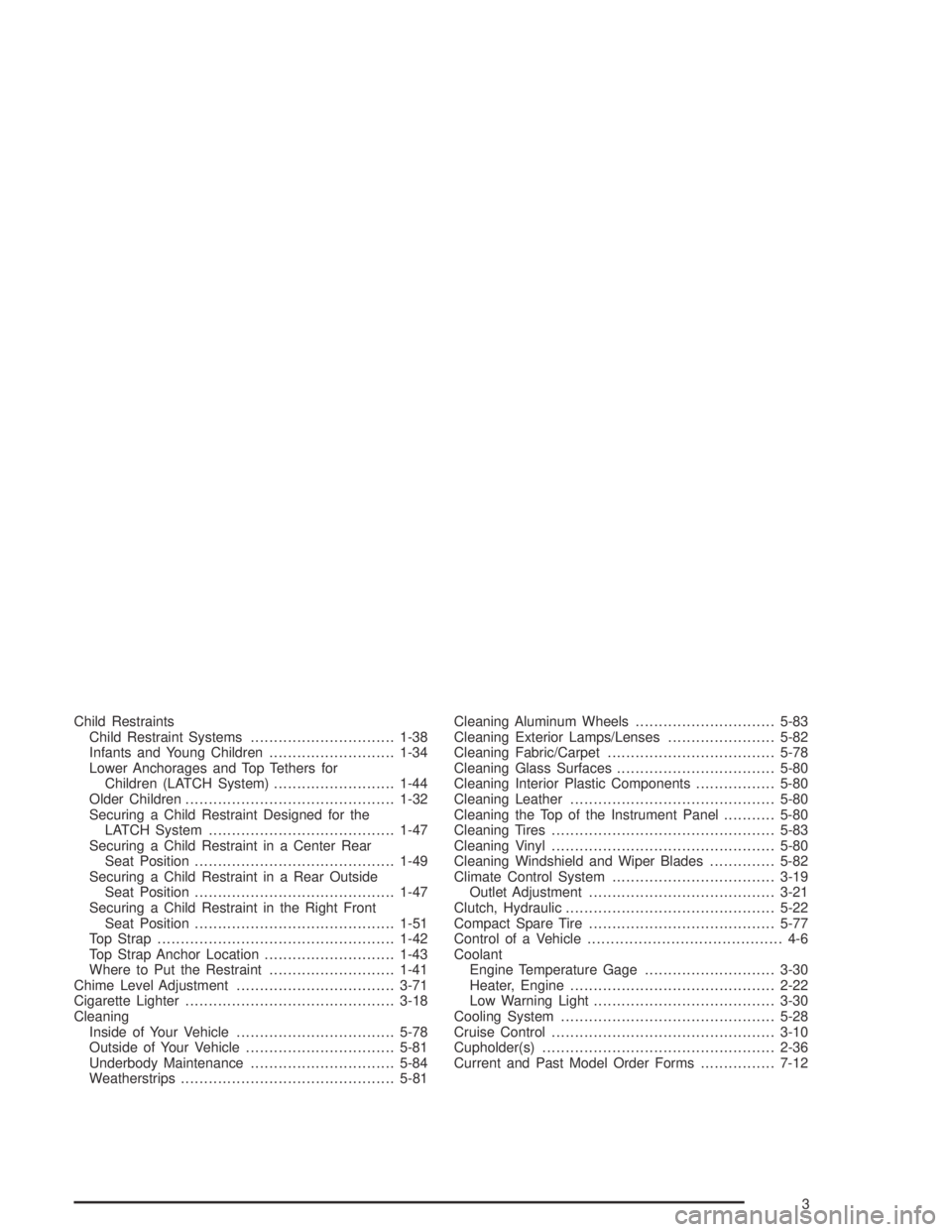
Child Restraints
Child Restraint Systems...............................1-38
Infants and Young Children...........................1-34
Lower Anchorages and Top Tethers for
Children (LATCH System)..........................1-44
Older Children.............................................1-32
Securing a Child Restraint Designed for the
LATCH System........................................1-47
Securing a Child Restraint in a Center Rear
Seat Position...........................................1-49
Securing a Child Restraint in a Rear Outside
Seat Position...........................................1-47
Securing a Child Restraint in the Right Front
Seat Position...........................................1-51
Top Strap...................................................1-42
Top Strap Anchor Location............................1-43
Where to Put the Restraint...........................1-41
Chime Level Adjustment..................................3-71
Cigarette Lighter.............................................3-18
Cleaning
Inside of Your Vehicle..................................5-78
Outside of Your Vehicle................................5-81
Underbody Maintenance...............................5-84
Weatherstrips..............................................5-81Cleaning Aluminum Wheels..............................5-83
Cleaning Exterior Lamps/Lenses.......................5-82
Cleaning Fabric/Carpet....................................5-78
Cleaning Glass Surfaces..................................5-80
Cleaning Interior Plastic Components.................5-80
Cleaning Leather............................................5-80
Cleaning the Top of the Instrument Panel...........5-80
Cleaning Tires................................................5-83
Cleaning Vinyl................................................5-80
Cleaning Windshield and Wiper Blades..............5-82
Climate Control System...................................3-19
Outlet Adjustment........................................3-21
Clutch, Hydraulic.............................................5-22
Compact Spare Tire........................................5-77
Control of a Vehicle.......................................... 4-6
Coolant
Engine Temperature Gage............................3-30
Heater, Engine............................................2-22
Low Warning Light.......................................3-30
Cooling System..............................................5-28
Cruise Control................................................3-10
Cupholder(s)..................................................2-36
Current and Past Model Order Forms................7-12
3
Page 356 of 364

L
Lamps
Exterior......................................................3-14
Interior.......................................................3-17
Lap Belt........................................................1-28
Lap-Shoulder Belt...................................1-14, 1-23
LATCH System
Child Restraints...........................................1-44
Securing a Child Restraint Designed for the
LATCH System........................................1-47
Latches, Seatback............................................ 1-5
Leaving Your Vehicle.......................................2-11
Leaving Your Vehicle With the Engine Running
(Automatic Transaxle Only)...........................2-31
Lift Seat, Power............................................... 1-7
Light
Air Bag Readiness.......................................3-25
Anti-Lock Brake System Warning...................3-28
Brake System Warning.................................3-27
Change Engine Oil......................................3-35
Charging System.........................................3-26
Enhanced Traction System (ETS) Active Light....3-29Light (cont.)
Enhanced Traction System (ETS) Warning
Light......................................................3-28
Low Coolant Warning...................................3-30
Low Washer Fluid Warning...........................3-36
Malfunction Indicator....................................3-31
Oil Pressure...............................................3-34
Safety Belt Reminder...................................3-25
Security.....................................................3-35
Service Vehicle Soon...................................3-36
Up-Shift.....................................................3-26
Loading Your Vehicle.......................................4-35
Lockout Protection..........................................2-11
Locks
Delayed Locking........................................... 2-8
Door........................................................... 2-7
Leaving Your Vehicle....................................2-11
Lockout Protection.......................................2-11
Power Door.................................................. 2-8
Programmable Automatic Door Locks............... 2-8
Rear Door Security Locks.............................2-10
Loss of Control...............................................4-15
Low Coolant Warning Light..............................3-30
Low Washer Fluid Warning Light.......................3-36
8